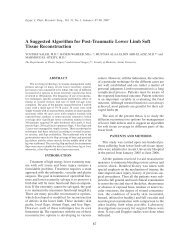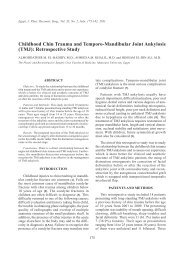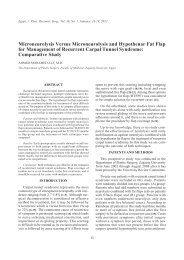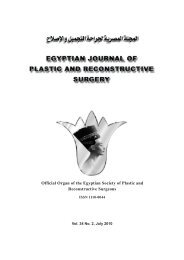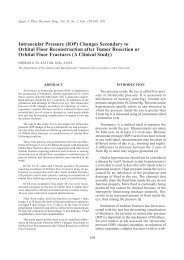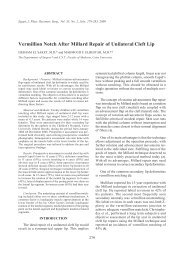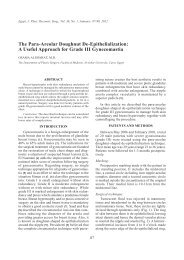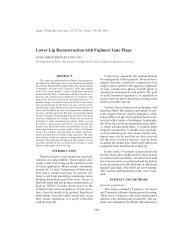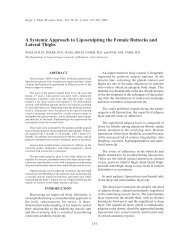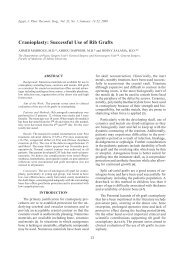Flexor Tendon Injuries: A Protocol Based on Factors that ... - ESPRS
Flexor Tendon Injuries: A Protocol Based on Factors that ... - ESPRS
Flexor Tendon Injuries: A Protocol Based on Factors that ... - ESPRS
Create successful ePaper yourself
Turn your PDF publications into a flip-book with our unique Google optimized e-Paper software.
Egypt, J. Plast. Rec<strong>on</strong>str. Surg., July 2009 149<br />
Postoperative tend<strong>on</strong> moti<strong>on</strong> exercise is popularly<br />
employed after primary tend<strong>on</strong> repair, but<br />
exact protocols for rehabilitati<strong>on</strong> vary greatly<br />
am<strong>on</strong>g countries or even am<strong>on</strong>g hand surgery<br />
centers in the same country. <str<strong>on</strong>g>Protocol</str<strong>on</strong>g>s for passive<br />
flexi<strong>on</strong> (active extensi<strong>on</strong> of the fingers with rubber<br />
band tracti<strong>on</strong>) are still in use in some hand units.<br />
However, over the last 5-10 years, there has been<br />
a trend towards combined active-passive finger<br />
flexi<strong>on</strong> without rubber band tracti<strong>on</strong>, because<br />
rubber band tracti<strong>on</strong> limits full extensi<strong>on</strong> of the<br />
finger; while extensi<strong>on</strong> loss is a frequent complicati<strong>on</strong><br />
[21]. In Duran and Houser, protocol, a dorsal<br />
splint or cast holds the wrist in 20 degrees of<br />
flexi<strong>on</strong> and the finger in a relaxed unspecified<br />
positi<strong>on</strong> of protective flexi<strong>on</strong> by means of a rubber<br />
band attached to a suture through the fingernail,<br />
to keep the tend<strong>on</strong> <strong>on</strong> slack. Two times a day, the<br />
patient performs six to eight repetiti<strong>on</strong>s of two<br />
exercises. Both exercises push flexor tend<strong>on</strong>s<br />
proximally and then pull them distally: Passive<br />
flexi<strong>on</strong> and extensi<strong>on</strong> of the DIP joint while the<br />
PIP and MP are held in flexi<strong>on</strong> and passive flexi<strong>on</strong><br />
and extensi<strong>on</strong> of the PIP while the DIP and MP<br />
are held in flexi<strong>on</strong>. Through intraoperative observati<strong>on</strong>s,<br />
it was observed <strong>that</strong> these exercises imparted<br />
3 to 5mm of passive glide to the tend<strong>on</strong>,<br />
and they c<strong>on</strong>sidered this to be sufficient to prevent<br />
formati<strong>on</strong> of restrictive adhesi<strong>on</strong>s. Strickland and<br />
Glogovac introduced the modified Duran approach<br />
which is in use by many therapists today: A dorsal<br />
splint holds the wrist and MP joints flexed and the<br />
interphalangeal (IP) joints are strapped in extensi<strong>on</strong><br />
between exercise sessi<strong>on</strong>s. The original Duran<br />
exercises are supplemented by composite passive<br />
flexi<strong>on</strong> and active extensi<strong>on</strong> as far as allowed by<br />
the splint. Both logic and clinical studies tell us<br />
<strong>that</strong> including composite passive flexi<strong>on</strong> will produce<br />
greater passive flexor tend<strong>on</strong> movement.<br />
Some of the best results with an early passive<br />
mobilizati<strong>on</strong> protocol are in patients who inadvertently<br />
or c<strong>on</strong>sciously flex their fingers actively.<br />
This makes great sense logically. Passive flexi<strong>on</strong><br />
attempts to push the tend<strong>on</strong> proximally, but the<br />
tend<strong>on</strong> is designed to pull, not to push. Edema is<br />
a normal part of healing after repair, even if the<br />
tend<strong>on</strong> is cut cleanly, with minimal injury to adjacent<br />
tissues and is repaired expeditiously and well.<br />
Any repair is bulkier than an uninjured tend<strong>on</strong>.<br />
Any associated injury will produce additi<strong>on</strong>al<br />
edema. All of these factors produce resistance to<br />
tend<strong>on</strong> movement. Some have noted ''buckling'' of<br />
the tend<strong>on</strong> rather than gliding with passive movement.<br />
Obviously, carefully c<strong>on</strong>trolled active flexi<strong>on</strong><br />
should produce greater tend<strong>on</strong> movement than does<br />
passive flexi<strong>on</strong>. These active mobilizati<strong>on</strong> protocols<br />
are possible <strong>on</strong>ly because of the evoluti<strong>on</strong> of surgical<br />
techniques. It is well established <strong>that</strong> the<br />
strength of the core suture is related to the number<br />
of strands crossing the repair) and <strong>that</strong> a str<strong>on</strong>g<br />
peripheral suture both improves gliding and increases<br />
suture strength [22].<br />
In our study, further management was based<br />
<strong>on</strong> the fact of <strong>that</strong> early mobilizati<strong>on</strong> will enhance<br />
the intrinsic healing of the tend<strong>on</strong>, minimizes<br />
adhesi<strong>on</strong>s, stiffness and thus minimizes the limitati<strong>on</strong>s<br />
of movement. And in the same time, immobilizati<strong>on</strong><br />
helps extrinsic tend<strong>on</strong> healing and adhesi<strong>on</strong><br />
formati<strong>on</strong>. So, we splinted the wrist in 20<br />
degree of flexi<strong>on</strong> and MPJ at 40 degree [23], we<br />
planned for dynamic splinting of involved digits<br />
with early passive and active but c<strong>on</strong>trolled moti<strong>on</strong>s<br />
to avoid possible problems related to early movement<br />
such as rupture of the repaired tend<strong>on</strong>. C<strong>on</strong>trolled<br />
active movement (CAM) after flexor tend<strong>on</strong><br />
repair was advised by several authors since the<br />
last decades till now [24-28]. We found <strong>that</strong> the<br />
CAM protocol <strong>that</strong> was described by Elliott [23]<br />
was easy to be described to and to be applied even<br />
by the patient him/her self. The protocol starts the<br />
CAM from the first postoperative day, every hour<br />
for ten repetiti<strong>on</strong>s active extensi<strong>on</strong> and flexi<strong>on</strong> of<br />
fingers while the hand is in the splinted positi<strong>on</strong><br />
and passively the DIPJ is then fully flexed. In our<br />
applicati<strong>on</strong>, we waited till postoperative pain subsided<br />
during which the patient may be hospitalized<br />
as describe also by Elliot, et al. [29]. The use of<br />
Postoperative therapeutic ultrasound from the 5 th<br />
day, was d<strong>on</strong>e for a limited number of cases, aiming<br />
of reducing pain during finger movement, reducing<br />
edema and enhance maturati<strong>on</strong> of the collagen<br />
fibers and intrinsic tend<strong>on</strong> healing. That was based<br />
<strong>on</strong> the study d<strong>on</strong>e by Gabriel and Dicky [30] who<br />
used therapeutic ultrasound <strong>on</strong> tend<strong>on</strong> Achilles.<br />
In c<strong>on</strong>clusi<strong>on</strong>, immediate active mobilizati<strong>on</strong><br />
following repairs of complete secti<strong>on</strong>s of the flexor<br />
tend<strong>on</strong>s is, at present, a challenge in hand surgery<br />
which faces two major stumbling blocks. On <strong>on</strong>e<br />
hand, surge<strong>on</strong> has to obtain a sufficiently solid<br />
repair to permit active finger flexi<strong>on</strong> and <strong>on</strong> the<br />
other hand, to determine a sector of mobilizati<strong>on</strong><br />
which would allow maximal excursi<strong>on</strong> of the repair<br />
site without additi<strong>on</strong>al risk of early rupture [18].<br />
The tensile strength and gliding functi<strong>on</strong>s are<br />
greater in the postoperatively mobilized tend<strong>on</strong>s,<br />
whereas adhesi<strong>on</strong> formati<strong>on</strong> is greater in immobilized<br />
tend<strong>on</strong>s [11]. We found our protocol is a safe,<br />
simple, scientifically accepted protocol and gives<br />
an excellent functi<strong>on</strong>al results for a repaired tend<strong>on</strong><br />
with no or at least minimal morbidity.




